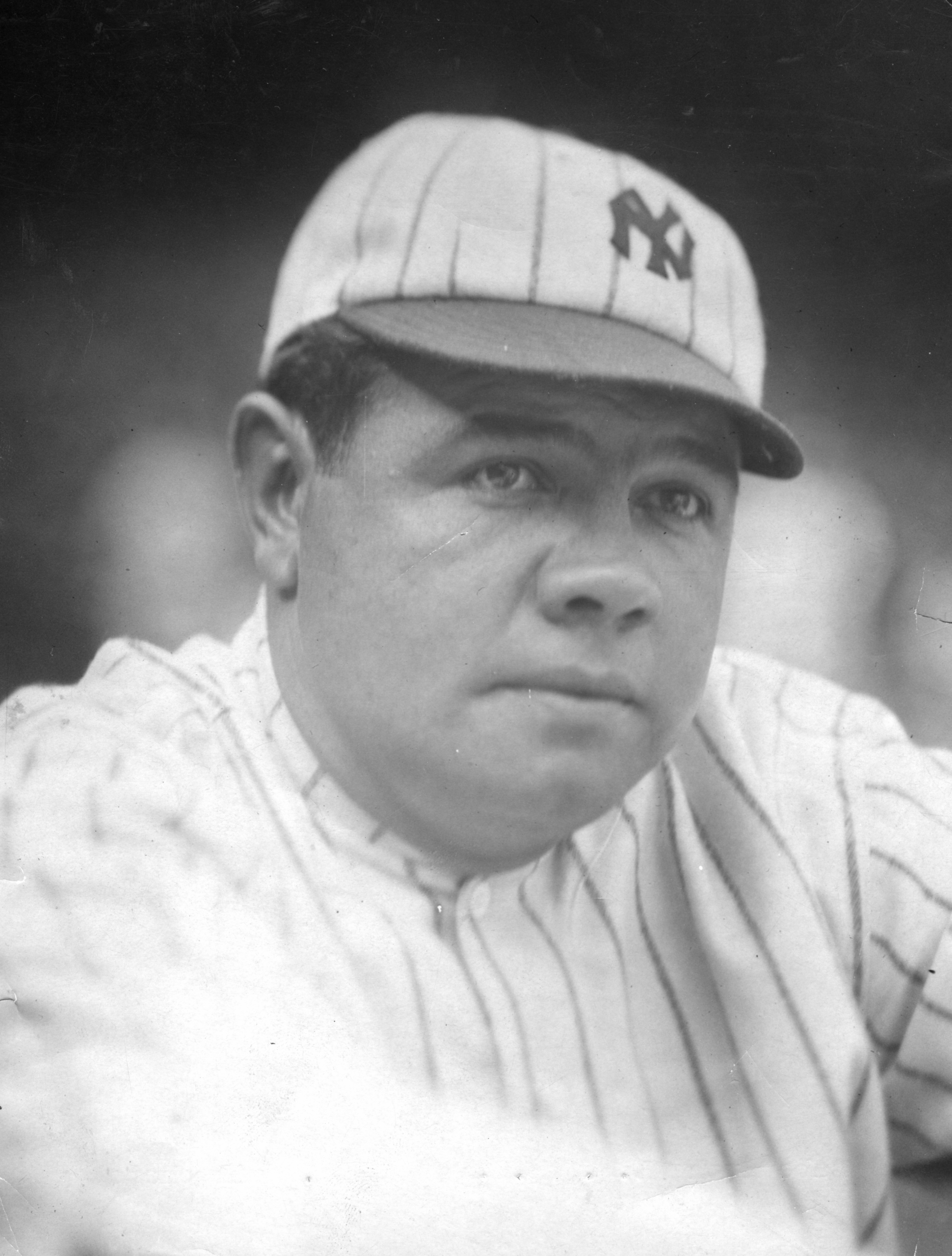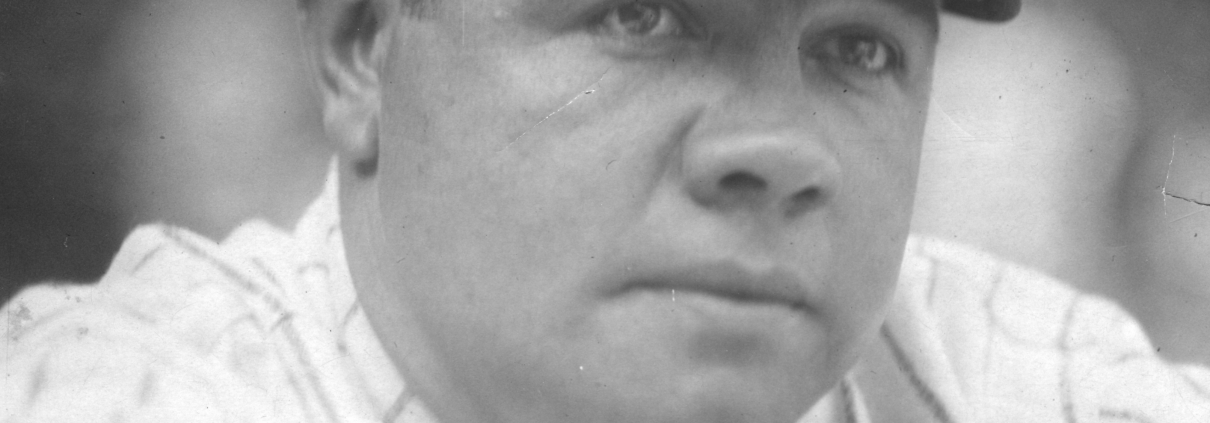October 9, 1921: Injured Babe Ruth wallops his first World Series home run
 On Sunday, October 9, 1921, the sporting world was obsessed with one question: Would Babe Ruth play in Game Four of the World Series?
On Sunday, October 9, 1921, the sporting world was obsessed with one question: Would Babe Ruth play in Game Four of the World Series?
Three days earlier, the Yankees slugger seriously injured his left forearm, gashing it below the elbow while sliding into third base in the eighth inning of his team’s second consecutive 3-0 victory over the New York Giants. The next day, the Babe played despite the pain, but aggravated the injury attempting a steal in the Giants’ 13-5 thrashing. That evening, the wound became infected, necessitating Dr. George D. Stewart to lance and drain it, rendering the game’s biggest star and gate draw unavailable for Game Four, scheduled for Saturday at the Polo Grounds, the home park for both clubs. But the Sultan of Swat and the Bronx Bombers caught a break. Inclement weather postponed the game; however, Yankees skipper Miller Huggins wasn’t sure when Ruth would return. “It is difficult to figure just how long it will take for such a wound to heal sufficiently enough to permit the arm to be subjected to the rigors of throwing and batting,” he said.1 Many sportswriters predicted that Ruth would miss the rest of the fall classic.
As the first of 36,372 spectators poured into the Polo Grounds for Game Four, it appeared as if Ruth would not play. His designated replacement in left field, Chick Fewster, took BP and shagged fly balls. About 30 minutes before the 2 P.M. start time, Babe “burst heroically” onto the field, gushed New York sportswriter James Whittaker in the Daily News.2 “[I]t is more and more apparent,” Whittaker continued, “that Mr. Ruth is superior to the common vicissitudes of our national pastime.”
The 26-year-old Ruth was indeed a larger-than-life figure. His home-run blasts had transformed the sport and signaled the end of the Deadball Era. He was coming off an unfathomable campaign, his second with the Yankees after his acquisition from the Boston Red Sox, setting new records for home runs (59) and RBIs (168). Ruth was no stranger to baseball’s biggest stage, either. He helped the Red Sox to World Series championships in 1916 and 1918, tossing three complete-game victories, yielding three earned runs in 31 innings. If the Bambino had a weak spot on his already otherworldly resume, it might have been his hitting in the World Series. He was just 3-for-18, though he had knocked in six runs, but he was still searching for his elusive first home run.
As a light mist gave way to sunny skies, Game Four commenced under ideal conditions and featured the pitching matchup from the opening game. Each team alternated as host, so it was the Yankees’ turn to take the field first and right-hander Carl Mays toed the rubber. The 29-year-old submariner, whose throwing style the New York Times chided as “uncouth,” had led the AL with 27 victories, the fourth time in five seasons he won at last 20 games, and owned a 134-74 career slate.3 Nationally syndicated sportswriter Westbrook Pegler noted that Mays “specialized in a ball that starts about where Achilles got shot and climbs a wobbly course up to the plate.”4 Like Ruth, the Yankees had obtained Mays from the Red Sox, albeit during the 1919 season. And like Ruth, he had excelled on the mound in the World Series, tossing two complete-game victories in the ’18 Series and shutting out the Giants on five hits in Game One of this Series. He breezed through the first five innings of this game, holding the NL’s highest-scoring offense hitless.
On the slab for skipper John “Little Napoleon” McGraw was 31-year-old journeyman Shufflin’ Phil Douglas. Playing for his fifth team, Douglas was coming off a sturdy campaign with a career-best 15 wins yet sported a losing lifetime slate (83-89) in parts of eight seasons. He was nicked for five hits and three runs over eight frames in Game One and was tagged with the loss but looked sharp early in this contest. The Yankees, who had set a new American League record for runs scored (948) in the twentieth century, managed just two innocuous singles (one by Ruth) through four frames. Wally Pipp led off the fifth with a single and moved up a station on Aaron Ward’s sacrifice bunt, but was then caught off base on Mike McNally’s sharp grounder to third base. Wally Schang sent a shot to deep left field. According to scribe W.J. MacBeth in the New York Tribune, the clout appeared to be the first home run of the Series, but “missed landing in the bleachers by inches” and caromed off the wall for an RBI triple.5
With mounting tension produced by the pitchers’ duel, Mays surrendered his first hit, a single to George Burns, with two outs in sixth, and another one in the seventh. Douglas, who had tied for the NL lead with three shutouts, kept pace. The notorious spitballer subdued the high-flying Yankees with an assortment of offerings, described by the Times as a “slow dipping curve, a fast ball with a leap, a fast drop and an outside curve that grazed the corners of the plate.”6
The turning point of the game, indeed the entire best-of-nine World Series, was the fateful eighth inning. “In that space of a quarter hour or so,” opined the Times, “the Giants rose in their might, swept over the powerless Mays with the same fury that they swept over lesser pitchers on Friday [in Game Three], and rescued a game that seemed well-nigh lost.”7 The Giants’ Irish Meusel (whose brother Bob was star for the Yankees) led off the frame with a blast into the left-center-field gap that rolled to the wall for a triple. Johnny Rawlings, an “obscure and unsung” journeyman, wrote the Times, singled to right to drive in Meusel for the tying run.8 Up stepped slow-footed Frank Snyder, who had been robbed of a hit two innings earlier by third baseman Mike McNally’s “marvelous one-hand catch” on the run (according to the Tribune).9 On McGraw’s orders, Snyder executed a perfect sacrifice bunt down the first-base line. Mays had an easy play on the ball; however, “instead of stopping it, he sprawled in the ground,” reported the Times, and the ball rolled away.10 Douglas followed with another sacrifice bunt to move up both runners. Burns doubled to left, driving in Rawlings and Snyder and giving the Giants the lead, 3-1.
After a scoreless eighth, the Giants tacked on a run when Irish Meusel’s one-out single drove home High Pockets Kelly, who had doubled.
Trailing 4-1, the Bombers had three outs to mount a comeback against Douglas, who had scattered six hits and quietly and unexpectedly emerged as an unlikely hero of the game. His “spitter broke in such baffling fashion,” gushed sportswriter Edward F. Ballinger, “and his control was so perfect that the Yankees were at their wits end.”11 With one out in the frame, Ruth caught what sportswriter Jack Lawrence of the Tribune described as a “low-breaking spitter” with a mighty thud of the bat.12 According to the Times, the “ball shot on a fairly high arch toward right field, leaped through the opening between the grandstand and bleaches and disappeared,” for the Babe’s first home run in World Series play.13 The crowd, which was equally divided between Giants and Yankees fans, erupted into a “tumultuous salvo,” noted Lawrence, as Ruth round the bases. The normally jovial slugger “trotted disgustedly around the bases and failed to loft his cap to the applause of the crowd,” wrote syndicated columnist William Slavens McNutt.14 Ruth, perhaps perturbed that his clout lacked a flair for the dramatic, would have plenty of additional chances to enjoy a home-run trot in the World Series: He belted 15 Series round-trippers in his career, though not another one in 1921. Unfazed, Douglas retired Bob Meusel on a popup to the catcher, and then fielded Pipp’s grounder and raced first to end the game in 1 hour and 38 minutes.
“[T]he biggest halo of all should go to Shufflin’ Phil Douglas whose long arms and round shoulders contained enough power to keep even Huggins’s great sluggers at a distance,” glowed one report.15 He didn’t issue a walk and fanned eight (including five swinging), the most strikeouts in a World Series game since the Cincinnati Reds’ Hod Eller punched out nine Chicago White Sox in a 5-0 shutout in Game Five of the 1919 series.
The game “confounded all the prophets,” wrote the Times.16 Ruth wasn’t expected to play, yet did and blasted a round-tripper. Mays mowed down the Giants with ease, destined for another shutout, yet lost the game. More than anything, the victory suddenly and dramatically shifted the momentum. “The Giants started the series apprehensive and uncertain,” opined the Times. “Now they know their power.”17 The World Series had been reduced to the best-of-five and a test of wills: McGraw’s small ball vs. Huggins’s bashers.
Sources
In addition to the sources cited in the Notes, the author also accessed Retrosheet.org, Baseball-Reference.com, SABR.org, and The Sporting News archive via Paper of Record.
Notes
1 “Ruth Out, Probably for Series, as Rain Prevents 4th Game,” New York Times, October 9, 1921: 1.
2 James Whittaker, “Ruth Earns a Pass for Rest of Series,” Daily News (New York), October 10, 1921: 3.
3 “Ruth’s Appearance Fooled Dopesters,” New York Times, October 10, 1921: 16.
4 Westbrook Pegler (United News), “Battle for Three Out of Next Five Games Starts,” Pittsburgh Post, October 10, 1921: 8.
5 W.J. MacBeth, “Carl Mays’s Magic Spell Fails When Giants Get Eyes on Ball,” New York Tribune, October 10, 1921: 11.
6 “Ruth Gets a Homer but Giants Win, 4-2; World’s Series Tied,” New York Times, October 10, 1921: 1.
7 Ibid.
8 Ibid.
9 MacBeth.
10 “Ruth Gets a Homer but Giants Win, 4-2; World’s Series Tied.”
11 Edward F. Ballinger, “Ruth Disregards Order to Remain Out of Struggle,” Pittsburgh Post, October 10, 1921: 8.
12 Jack Lawrence, “Salvo of Hits Ends Pitching Duel in Favor of McGraw Men,” New York Tribune, October 10, 1921: 11.
13 “Ruth Gets a Homer but Giants Win, 4-2; World’s Series Tied.”
14 William Slaven McNutt (United News), “Giants’ Strong Man Overcomes Weaker Opponents and Wins,” Pittsburgh Post, October 10, 1921: 8.
15 “Ruth Gets a Homer but Giants Win, 4-2; World’s Series Tied.”
16 “Ruth’s Appearance Fooled Dopesters.”
17 “Ruth Gets a Homer but Giants Win, 4-2; World’s Series Tied.”
Additional Stats
New York Giants 4
New York Yankees 2
Game 4, WS
Polo Grounds
New York, NY
Box Score + PBP:
Corrections? Additions?
If you can help us improve this game story, contact us.


